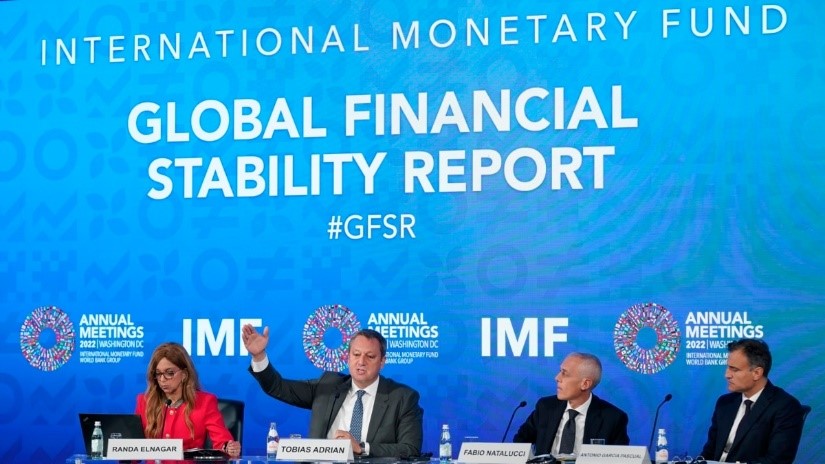
Disclaimer: Copyright infringement not intended.
Context:
- The International Monetary Fund (IMF) recently released its latest Global Financial Stability Report, highlighting several key risks to the global financial system.
Highlights of the Report
IMF’s Concerns:
Inflation Risks
- Investors' Optimism: Investors have been optimistic about the end of high inflation, pushing up asset prices such as stocks.
- Premature Enthusiasm: The IMF believes this optimism may be premature, as core inflation in some major economies has not shown a sustained decrease.
- Geopolitical Risks: Ongoing conflicts in regions like West Asia and Ukraine could disrupt supply chains and lead to higher prices, affecting central banks' decisions on interest rates.
Risks in the Unregulated Credit Market
- Increasing Lending: The IMF is concerned about the rise in lending in unregulated credit markets.
- Financial Stability Risks: This trend poses risks to financial stability, especially if borrowers default on their loans, potentially leading to a financial crisis.
Cybersecurity Threats
- Disruptive Attacks: The IMF has highlighted the increasing cyber-attacks on financial institutions.
- System Disruption: These attacks could disrupt financial systems, causing instability and loss of confidence.
IMF's Assessment and Warning
Premature Investor Optimism
- Stalled Inflation: Core inflation in some major economies has not shown a sustained decrease, indicating that inflation may not be as under control as believed.
- Central Bank Response: Central banks may delay lowering interest rates, contrary to investor expectations.
Geopolitical Risks
Impact on Inflation
- Supply Chain Disruption: Ongoing conflicts could disrupt supply chains, leading to higher prices.
- Central Bank Response: These risks may deter central banks from lowering interest rates, contrary to investor expectations.
Potential Consequences
Asset Price Correction
- Investor Response: If risks persist, investors expecting central bank actions may reverse their positions.
- Sharp Correction: This could lead to a sharp correction in asset prices, resulting in significant losses for investors.
What does it mean for India?
- Fund Flows and Foreign Capital: India has been a significant recipient of foreign capital, with strong fund flows into emerging markets driven by optimism over central banks easing interest rates. However, this trend could reverse if western central banks signal high interest rates for an extended period.
- Currency Pressure and Depreciation: The Indian rupee has been under pressure and recently traded at a new low against the U.S. dollar. If investors pull money out of emerging markets like India, it could further depreciate the rupee and put pressure on the country's financial system.
- RBI's Response: The Reserve Bank of India (RBI) may need to defend the rupee by curbing liquidity to raise interest rates, potentially slowing down the economy in the process.
What about the Private Credit Market?
- Growing Concerns: The IMF highlighted concerns about the growing unregulated private credit market, where non-bank financial institutions lend to corporate borrowers. This market has grown to $2.1 trillion globally, raising concerns about its impact on the broader financial system.
- Financial Soundness of Borrowers: The IMF expressed concerns that borrowers in the private credit market may not be financially sound, with many not generating enough earnings to cover their interest costs.
- Lack of Market Liquidity: Loans in the private credit market often do not trade in an open, liquid market, making it challenging for investors to gauge the risks accurately. This lack of liquidity could lead to smaller markdowns in times of stress, delaying the pricing of real risks.
- Indian Scenario: India has seen the growth of a small private credit market, particularly with the rise of Alternative Investment Funds (AIFs). These funds cater to high-risk borrowers not served by traditional banking or non-bank financial companies.
- Regulatory Scrutiny: Financial regulators in India, including the RBI and the Securities and Exchange Board of India (SEBI), have increased scrutiny over these funds to ensure financial stability and mitigate risks.
READ TOPICS PERTAINING TO CORE CONCEPTS:
INFLATION:https://www.iasgyan.in/daily-current-affairs/inflation-19#:~:text=Inflation%20measures%20the%20average%20price,items%20is%20called%20'deflation'.
FED RATES: https://www.iasgyan.in/rstv/us-fed-rate
ALTERNATIVE INVESTMENT FUNDS: https://www.iasgyan.in/daily-current-affairs/rbi-tightens-norms-for-lenders-investing-in-aifs#:~:text=Alternative%20Investment%20Funds%20(AIFs)%20in,to%20take%20on%20higher%20risks.
ALL ABOUT IMF: https://www.iasgyan.in/daily-current-affairs/imf-12
ALL ABOUT MONETARY POLICY: https://www.iasgyan.in/daily-current-affairs/monetary-policy
ECONOMIC CONCEPTS: https://www.iasgyan.in/blogs/important-economic-concepts-for-upsc
|
PRACTICE QUESTION
Q. Which organization publishes the Global Financial Stability Report (GFSR)?
A) World Bank
B) International Monetary Fund (IMF)
C) Bank for International Settlements (BIS)
D) World Economic Forum (WEF)
Correct Answer: B) International Monetary Fund (IMF)
|




